In the second episode of the four-part mini-documentary series, 50 Best Explores Peru, chef Jock Zonfrillo travels to the Amazon with local chefs Pedro Miguel Schiaffino and Matias Cillóniz, finding parallels with the indigenous communities he meets back home – and a whole side of Peruvian gastronomy as yet undiscovered.
In a wooden shack set on stilts, deep inside the Amazon jungle, a young boy reclines in a hammock, watching an Australian soap opera with Portuguese subtitles. Although he watches on a flat-screen television, this is just about the only trace of modern technology in the village – the TV is powered by a generator, which will switch off at 10pm, plunging the small wooden building into darkness and replacing the Australian voices on the TV with the sound of crickets, exotic birds and monkeys.
A few doors down in a neighbouring dwelling, exhausted from the 15,000-kilometre journey from his home in Adelaide, Australia, chef Jock Zonfrillo makes the most of the pitch black sky and absence of internet signal for an early night. In the morning, he will wake with the sunrise and the call of cockerels, ready to explore Peru’s rainforest with fellow chefs Pedro Miguel Schiaffino and Matias Cillóniz.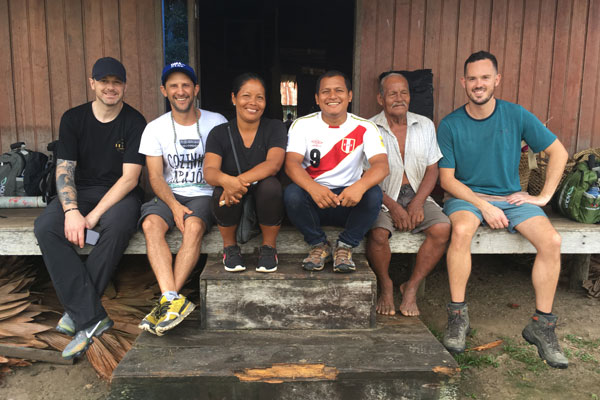
Zonfrillo, Schiaffino and Cillóniz with locals of the Bora and Huitoto communities
This is Zonfrillo’s second time visiting the village of Pucaurquillo, the first being for a TV series a few years prior. According to the chef, not much has changed – in a good way. There is no more technology than the last time he visited, and village life is just as slow and relaxed as it was before. One thing that has changed for the better, though, is that the two indigenous groups, the Huitotos and the Boras, are showing more pride in their local cuisine.
“It’s been nearly five years since I was here before and my heart has lifted a little bit that it hasn’t changed in a bad way, it hasn’t become commercialised,” says Zonfrillo. “The Huitotos and Boras are keeping up traditions, they’re keeping up the culture, they’re probably more organised and more enthusiastic and proud to show it to us as visitors, which I thought was beautiful. As soon as we walked into the community, we were welcomed with open arms and made to feel very at home.”
This sense of pride in their culture and cuisine is something that Pucaurquillo’s native people have only developed recently, with the help of Schiaffino, one of Peru’s leading chefs. When the Bora indigenous community first began to receive tourists around 20 years ago, they would put out plates of spaghetti and cans of tuna because they thought it was what people wanted to eat. Only in the last few years, since Schiaffino started to visit the village, have things started to change, and visitors are now served soups with local fish, umami-rich black yucca sauce and macambo, a relative of cacao used in savoury preparations.
“Before we came, they were ashamed of serving ají negro,” says Schiaffino, referring to the black sauce made by local women from the poisonous yucca plant, or manioc. “We changed that about four years ago when we started coming here.”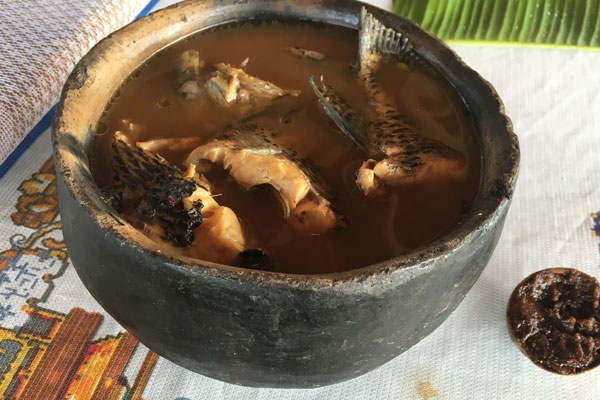
A fish soup with ají negro
Zonfrillo, the chef behind Orana restaurant and the Orana Foundation in Adelaide, says the renewed sense of pride in their local cuisine is something the Peruvian indigenous communities share with the ones he visits back home in Australia. The Glasgow-born cook, who won the Basque Culinary World Prize in 2018 for his work to preserve the cuisines of Australian indigenous communities over the last 17 years, says he has had similar experiences with indigenous Australians, and has worked to help build pride by rescuing food culture that may otherwise have been lost.
“It’s about valuing your own culture so that then the rest of the world will value it,” Zonfrillo says. “The same community spirit and pride applies here in Peru as in Australia. The Peruvian indigenous people and our indigenous people share a lot in common. The terroir, the environment is of course very different – we’re a lot more arid. We’ve got some tropical parts as well, but nothing like the Amazon. The Amazon is its own unique beast and the indigenous people that live here are also unique individuals. They have a very special culture and a very special connection to nature. It’s infectious and once you start learning about it, like most indigenous cultures, you just want to know more and more. Food is the perfect medium to do it.”
Like Zonfrillo in Australia, Schiaffino has been Peru’s champion of Amazonian ingredients and techniques for some time now. After the success of his Lima restaurant Malabar, which opened in 2004, and later his own catering company, the chef began to travel in search of new ingredients. This developed into a fascination with Amazonian ingredients and cooking techniques, and in 2012 he opened Ámaz (short for Amazon), which serves all things rainforest, from paiche fish steak to river snails to ribs of the gamitana, a fruit-eating piranha.
Watch the second episode of 50 Best Explores Peru:
For Schiaffino – and for other Peruvian chefs including Virgilio Martínez and Pía León, who are set to open a restaurant in the southern Amazon at the end of the year – the region that makes up 60% of Peru’s geography is vastly underestimated, underused and misunderstood. Schiaffino’s regular trips to the Bora and Huitoto communities are part of an effort to bring Amazonian ingredients to the mainstream in Lima, and eventually to export them beyond Peru.
One of those ingredients is ají negro, also known as tucupí preto on the Brazilian side of the Amazon. A rich, umami-like liquid similar to miso or Vegemite, black yucca sauce is the result of many hours of labour, and is only produced in 14 communities in Peru, as well as in Brazil. Like miso paste, it is most commonly used to add flavour to soups and sauces, and is far less well-known than the yellow tucupí often found in Peruvian and Brazilian cuisines.
Made from wild manioc or yucca, the sauce is the result of a long process carried out by the Bora and Huitoto women – a working group that has increased in size from four to 24 women since Schiaffino Gastronómica began selling the sauce back in the capital. Originally toxic, the wild yucca is handpicked by the women and carried on their heads to a maloka, a large, thatched hut made from palm fronds that forms the centre of each village. There, the women transform the yucca into flour before straining it to extract the water, mixing the dough with starch to make cassava or to make flour. The water sits for one night before being reduced to black sauce.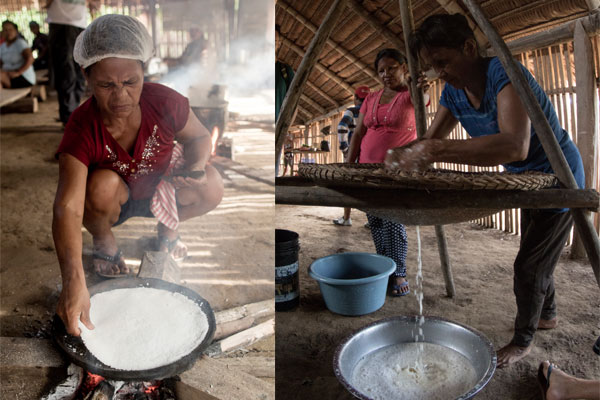
Women of Pucaurquillo making casabe (left) and straining yucca (right)
According to Schiaffino, the Boras and Huitotos have a longer lifespan than any other indigenous community in Peru due to the probiotic content of the black sauce, which strengthens the good bacteria in the stomach. This, along with its flavour value, is one of the reasons he is advocating it.
“The future of South American gastronomy is in the Amazon,” says Schiaffino. “The knowledge we find in these indigenous communities, which they’ve been keeping for a long time, are going to be very important in the future. For many years we haven’t paid attention to them – we thought they were poor and they didn’t have much knowledge. If we start looking to them, we’re going to start finding very interesting things and it’s going to change South American cuisine and gastronomy for sure.”
Matias Cillóniz of Mó Bistró in Lima is one of several young chefs who have been inspired by Schiaffino to help promote Amazonian ingredients and recipes. He brings back a sack of handmade tapioca balls from Pucaurquillo to the capital and creates a cold tapioca porridge with pineapple, coconut, lime and tonka bean, an homage to a drink the community makes with yucca starch and pineapple. He says the experience in the Amazon has inspired him to travel more within his own country to learn about its culture and traditions.
“I always want to learn more. I always want to have new ingredients to cook,” says Cillóniz. “The world now is closer than ever and it’s really important that we try to make the most out of our own identities and to nurture them and use them to feed people in our country, in Lima. In that way, we will have it for longer. We need to celebrate what we have, our ingredients, our culture, and try to know more, in a respectful manner, every day.”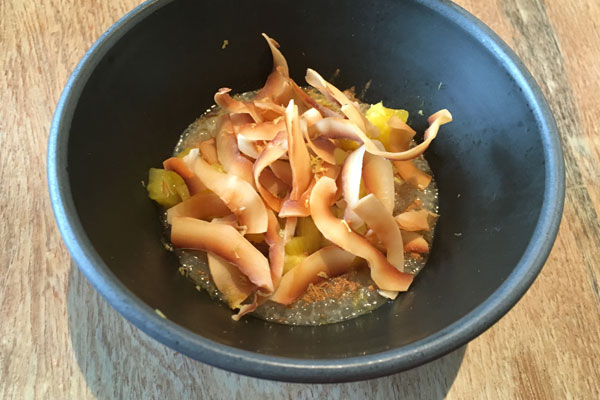
Tapioca porridge at Mó Bistró
Zonfrillo echoes that sentiment, adding that chefs around the world can help take responsibility to preserve the vast Amazon rainforest, which spans not just Brazil and Peru but also Colombia, Bolivia and Venezuela, and is threatened by increasing levels of deforestation.
“Awareness about the Amazon is just beginning,” Zonfrillo says. “[Brazilian chef] Alex Atala has been working on this for such a long time, as has Pedro, and a lot of people are talking about it, but I don’t think the world at large is hearing it. It’s until you’re forced to sit down and look at it – if you look at the logging and forestry issues in the Amazon in general, it’s outrageous and it’s something that you’re not really exposed to unless you go out looking for it, and that’s one of the problems. For me, it’s a problem that everyone needs to share because the Amazon is such a globally important site across multiple countries. If we start to lose a grasp on nature within the Amazon, we’re in a whole world of shit.”
Zonfrillo says people like Schiaffino are doing the right thing by using their platform as well-known chefs to bring attention to the Amazon and its traditions.
“It's awesome what chefs are doing in Lima. It made me so happy,” he says. “It’s exactly what we’re doing at home – we’re visiting communities, spending time with them for weeks at a time and learning, understanding not just them as people but their culture, their relationship to that plant or food or fish, then we’re bringing it back and putting it in a setting within gastronomy that a normal customer can relate to.
“The step towards understanding the people of the Amazon isn’t such a huge leap and all of these chefs are doing it in a way that is a nice and comfortable for the customer. It builds intrigue and the customer wants to know more, and then they might take a trip to the Amazon and maybe want to help in a couple of projects, who knows? That’s the most important part. To see so many restaurants using ingredients from the jungle is the ultimate goal for us in Australia. There are a lot of similarities between what chefs are doing in Australia and what chefs are doing in Peru.”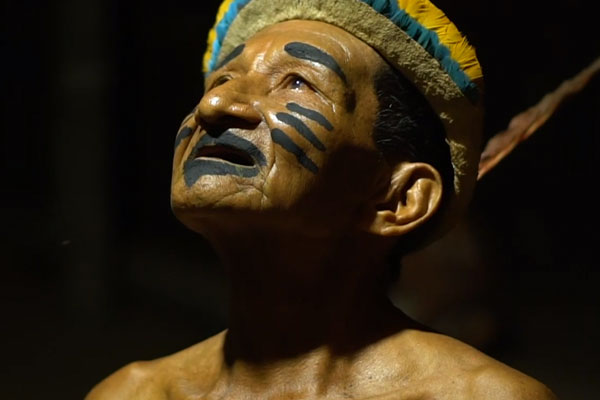
The chief, or apu, of the village
Back in Lima and ready to head back to Adelaide, Zonfrillo says he wants to make sure any future trips he takes to different countries are accompanied by local chefs, because the process of sharing knowledge with cooks around the world is so much more valuable than discovering a new place alone. He stresses the need to give back to the communities he explores, and says that chefs, together, have the power to create positive change as much in Australia as in Peru and around the world.
“The mantra of our business and the Orana Foundation is to give back more than you take – that’s the baseline, it’s a value that we all hold and it doesn’t matter if you’re a producer or a grower or even a customer. You can see that through gastronomy everywhere, I can see it here in Peru. The relationship that we have to create change as chefs is very, very different than a politician. It’s very very different than government, than business. We’re speaking a language of food. Gastronomy can create change, there’s no question about it, and it’s much easier to create change through gastronomy than it is any other medium.”
Now watch the first episode of the 50 Best Explores Peru series, featuring Daniela Soto-Innes:
Read about how Daniela Soto-Innes has joined Peruvian chefs Francesca Ferreyros and José del Castillo in the fight for a more sustainable fishing industry.
Now subscribe to 50 Best's YouTube channel for alerts on the rest of the 50 Best Explores Peru series, in partnership with PromPeru, where chefs Ana Ros and James Lowe explore the valley and the Andes.

